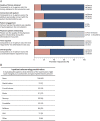Provider Impressions of Inpatient Teleneurology Consultation
- PMID: 38737514
- PMCID: PMC11087028
- DOI: 10.1212/CPJ.0000000000200296
Provider Impressions of Inpatient Teleneurology Consultation
Abstract
Background and objectives: Teleneurology usage has increased during the severe acute respiratory syndrome coronavirus 2 pandemic. However, studies evaluating physician impressions of inpatient teleneurology are limited. We implemented a quality improvement initiative to evaluate neurologists' impression following individual inpatient teleneurology consultation at a satellite hospital of a large academic center with no in-person neurology coverage.
Methods: A REDCap survey link was embedded within templates used by neurologists for documentation of inpatient consultations to be completed immediately after encounters. All teleneurology encounters with completed surveys at a single satellite hospital of the University of Pennsylvania Health System Neurology Department between May 10, 2021, and August 14, 2022, were included. Individual patient-level and encounter-level data were extracted from the medical record.
Results: A total of 374 surveys (response rate of 54.05%) were completed by 19 neurologists; 341 questionnaires were included in the analysis. Seven neurologists who specialized as neurohospitalists completed 231 surveys (67.74% of total surveys completed), while 12 non-neurohospitalists completed 110 (32.36%). The history obtained was rated as worse (14%) or the same (86%) as an in-person consult; none reported the history as better than nonteleneurology encounters. The physician-patient relationship was poor or fair in 25% of the encounters and good or excellent in 75% of visits. The overall experience was judged to be worse than in-person consultation in 32% of encounters, the same in 66%, and better in 2%. Fifty-one percent of providers responded that there were elements of the neurologic examination that might have changed their assessment and plan of care if performed in-person. Encounters with peripheral or neuromuscular-related chief complaints had the most inadequate examinations and worse overall experiences, while the most positive impressions of these clinical experiences were observed among seizure-related chief complaints.
Discussion: Determining best practices for inpatient teleneurology should consider the patient chief complaint to use teleneurology in scenarios with the highest likelihood of a positive experience. Further efforts should be made to the patient experience and to improve the remote examination to enhance the applicability of teleneurology to the full spectrum of inpatient neurologic consultations.
© 2024 American Academy of Neurology.
Conflict of interest statement
T.F. Tropea is additionally funded by the NINDS (K23 NS114167). All other authors report no disclosures relevant to the manuscript. Full disclosure form information provided by the authors is available with the full text of this article at Neurology.org/cp.
Figures



Similar articles
-
Sexual Harassment and Prevention Training.2024 Mar 29. In: StatPearls [Internet]. Treasure Island (FL): StatPearls Publishing; 2025 Jan–. 2024 Mar 29. In: StatPearls [Internet]. Treasure Island (FL): StatPearls Publishing; 2025 Jan–. PMID: 36508513 Free Books & Documents.
-
Home treatment for mental health problems: a systematic review.Health Technol Assess. 2001;5(15):1-139. doi: 10.3310/hta5150. Health Technol Assess. 2001. PMID: 11532236
-
A rapid and systematic review of the clinical effectiveness and cost-effectiveness of paclitaxel, docetaxel, gemcitabine and vinorelbine in non-small-cell lung cancer.Health Technol Assess. 2001;5(32):1-195. doi: 10.3310/hta5320. Health Technol Assess. 2001. PMID: 12065068
-
Signs and symptoms to determine if a patient presenting in primary care or hospital outpatient settings has COVID-19.Cochrane Database Syst Rev. 2022 May 20;5(5):CD013665. doi: 10.1002/14651858.CD013665.pub3. Cochrane Database Syst Rev. 2022. PMID: 35593186 Free PMC article.
-
Comparison of Two Modern Survival Prediction Tools, SORG-MLA and METSSS, in Patients With Symptomatic Long-bone Metastases Who Underwent Local Treatment With Surgery Followed by Radiotherapy and With Radiotherapy Alone.Clin Orthop Relat Res. 2024 Dec 1;482(12):2193-2208. doi: 10.1097/CORR.0000000000003185. Epub 2024 Jul 23. Clin Orthop Relat Res. 2024. PMID: 39051924
References
Grants and funding
LinkOut - more resources
Full Text Sources
